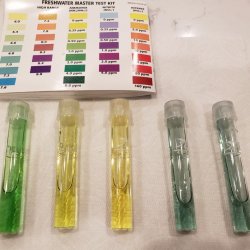Chloe07
Fish Fanatic
- Joined
- May 7, 2019
- Messages
- 68
- Reaction score
- 8
hello, recently I was having ammonia 0.25ppm regardless of frequent water change
I use RO water + seachem replenish to mineralize. It was weird since I have 1 betta with 1 low flow HOB filter and 1 small sponge filter.
Then I read someone mentioning fluval stratum raises ammonia.
I bought my fluval stratum from local Petco, so its not an old stock. I rinsed gently with RO water and put it in a bucket of same mineralized RO water that use for water change.
In the fish tank I had put only a handful of fluval stratum in a little pot planted with Amazon sword. I also have little anubias, and planned to put more plants after adding the fluval stratum.
I did 30% water change this morning and now I checked and its still 0.25ppm ammonia! (0ppm nitrite, 5ppm nitrate)
So I checked the bucket containing the fluval stratum (and it has been there for 3 days only) and the ammonia is 2.0 ppm. Please take a look at the picture.
starting from far left,
1st bottle. bucket of water containing full bag of fluval stratum for 3days
2. tank water
3. mineralized RO water (no water condition added)
4. PH of bucket containing fluval stratum
5. PH of mineralized RO water
The ph is the same. I heard Fluval stratum lowers the ph, my ph is about 7 so I was even afraid it would lower too much. But there is no ph change with fluval stratum.
Could someone explain the reason for this? So many people use Fluval stratum but wouldn't this ammonia level crash my cycle? I had 0 ammonia, 0 nitrite, 5 nitrate.
I thought it was my snail causing ammonia spike but I guess it was Fluval stratum?
I'm going to do another partial water change. should I remove the fluval stratum from the tank immediately?
I use RO water + seachem replenish to mineralize. It was weird since I have 1 betta with 1 low flow HOB filter and 1 small sponge filter.
Then I read someone mentioning fluval stratum raises ammonia.
I bought my fluval stratum from local Petco, so its not an old stock. I rinsed gently with RO water and put it in a bucket of same mineralized RO water that use for water change.
In the fish tank I had put only a handful of fluval stratum in a little pot planted with Amazon sword. I also have little anubias, and planned to put more plants after adding the fluval stratum.
I did 30% water change this morning and now I checked and its still 0.25ppm ammonia! (0ppm nitrite, 5ppm nitrate)
So I checked the bucket containing the fluval stratum (and it has been there for 3 days only) and the ammonia is 2.0 ppm. Please take a look at the picture.
starting from far left,
1st bottle. bucket of water containing full bag of fluval stratum for 3days
2. tank water
3. mineralized RO water (no water condition added)
4. PH of bucket containing fluval stratum
5. PH of mineralized RO water
The ph is the same. I heard Fluval stratum lowers the ph, my ph is about 7 so I was even afraid it would lower too much. But there is no ph change with fluval stratum.
Could someone explain the reason for this? So many people use Fluval stratum but wouldn't this ammonia level crash my cycle? I had 0 ammonia, 0 nitrite, 5 nitrate.
I thought it was my snail causing ammonia spike but I guess it was Fluval stratum?
I'm going to do another partial water change. should I remove the fluval stratum from the tank immediately?


